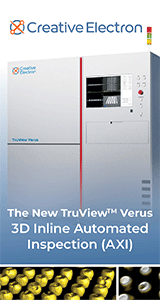Summary
The explosive growth of personal electronic devices, such as mobile phones, tablets, and personal music devices, has driven the need for smaller and smaller active and passive electrical components. Not long ago, 0201 passives were seen as the ultimate in miniaturization, but now we have 01005 passives with rumors of even smaller sizes not far behind. For active components, array packages with 0.4mm pitch are virtually a requirement for enabling the many features in modern portable electronic devices. To meet the challenge of stencil printing smaller stencil apertures, there is an increased interest in using finer particle-sized solder pastes to improve transfer efficiency. The smaller particle size results in a large surface area-to-volume ratio that challenges the solder paste's flux to effectively perform its fluxing and oxidation protection action.
The potential resulting surface oxidation can lead to voiding, graping, head-inpillow, and other defects. The combination of higher lead-free process temperatures, smaller print deposits, and temperature restraints on electrical components have created several challenges. Two in particular include obtaining consistent volume in the printed solder paste deposit and minimizing the oxidation of the solder powder in the small deposit during reflow. Solder pastes comprised of finer particle solder powders may help with stencil printing, but the increased surface oxide associated with finer powders may also reduce the reflow process window. The focus of this paper is to provide a statistical comparison of the transfer efficiency of different solder powder particle sizes, specifically types 3, 4, 5, and 6, and to visually observe post reflow results in both optimal and harsh conditions.
Conclusions
The utilization of ultrafine solder powders can improve transfer efficiency in the stencil printing process and effectively reduce the area ratio acceptance level to 0.50. Some contributing factors need to be considered such as square vs. circle and solder mask defined pads vs. copper defined to attain desirable results.
A trade-off when choosing ultrafine solder pastes is the premature flux exhaustion due to an increase in total surface oxide, and sensitivity of the smaller paste deposit - utilized for the oven environment. The total heat excursion that the solder paste endures may need to be optimized. Striving for a ramp to peak type profile with a peak temperature 240-245C (SAC305), time above liquidus 45-60s, and an average ramp rate 1-1.5C/s is ideal. No-clean flux formulations provide more oxidation resistance than water soluble formulations and can widen a reflow process window, especially if a ramp to peak profile is not attainable.
|




